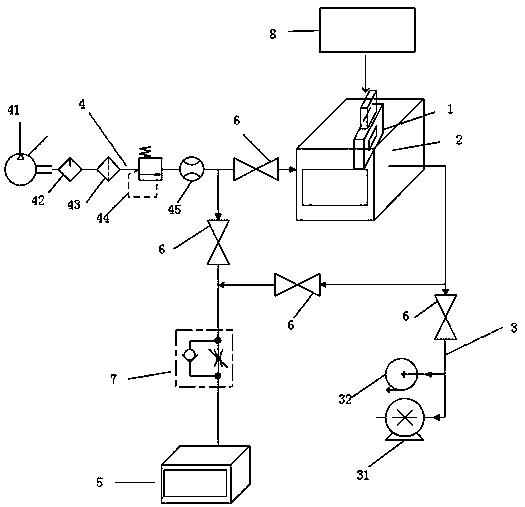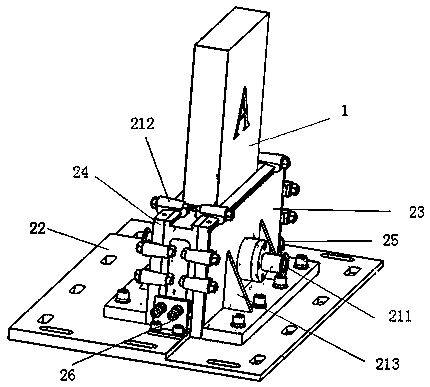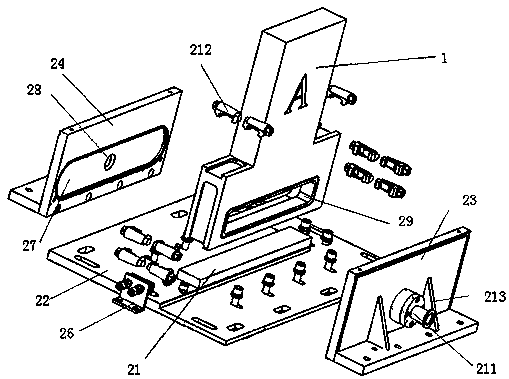System for detecting number of fallen particles during working process of valve
A working process and particle counter technology, which is applied in the direction of measuring devices, mechanical valve testing, individual particle analysis, etc., can solve problems such as the quality impact of semiconductors or photovoltaic modules, and achieve the effect of easy operation and simple detection principle
- Summary
- Abstract
- Description
- Claims
- Application Information
AI Technical Summary
Problems solved by technology
Method used
Image
Examples
Embodiment 1
[0059] This embodiment provides a system for detecting the number of particles falling off during valve operation, which includes a vacuum device, a valve to be tested 1, a valve drive device to be tested 8, a gas inlet device 4 and a particle counter 5, and the vacuum device includes The cavity 2 and the vacuuming device 3, the cavity 2 is connected with three pipelines, one of which is a gas inlet pipeline, one of which is an outlet pipeline, and the last one is a vacuuming pipeline, which is connected to the vacuuming device 3. The gas inlet pipeline is connected to the gas inlet device 4, the outlet pipeline is connected to the particle counter 5, the gas inlet device 4 is connected to the particle counter 5 through a branch pipeline, and the valve driving device 8 to be tested is connected to the valve 1 to be tested. The valve driving device 8 drives the valve 1 to be tested to open and close. The valve 1 to be tested is placed in the cavity 2. Valves are installed on the...
Embodiment 2
[0074] The method for detecting the number of particles falling off during the working process of the valve provided in this embodiment is specifically (for the convenience of illustration, combined with figure 1 Be explained):
[0075] Step 1: Connect the gas inlet device 4, the vacuum device 3 and the particle counter 5 on the cavity 2, insert the valve 1 to be tested into the cavity 2, connect the valve 1 to be tested to the valve driving device 8, and drive the valve driving device 8 The valve 1 to be tested is opened and closed; the valve I6 is installed on the connecting pipeline between the gas inlet device 4 and the cavity, the valve II61 is installed on the pipeline connecting the gas inlet device 4 and the particle counter 5, and the valve II61 is installed on the pipeline connecting the gas inlet device 4 and the cavity. Install valve Ⅲ62 on the pipeline connected to 2, and install valve Ⅳ63 on the pipeline connected to the vacuum device 3 and the cavity; firstly cl...
Embodiment 3
[0080] This embodiment is basically the same as Embodiment 2, except that the gas is introduced into the cavity 2 through the gas inlet device 4 first, and then the gas enters the cavity 2 and then enters the particle counter 5 for counting, and records the value displayed by the particle counter. Number a1, and then clear the particle counter, pass the gas with the same flow rate into the particle counter that has been cleared through the gas inlet device for counting, record the number b1 displayed by the particle counter, and calculate the number of particles falling off c1=a1 -b1.
PUM
 Login to View More
Login to View More Abstract
Description
Claims
Application Information
 Login to View More
Login to View More - Generate Ideas
- Intellectual Property
- Life Sciences
- Materials
- Tech Scout
- Unparalleled Data Quality
- Higher Quality Content
- 60% Fewer Hallucinations
Browse by: Latest US Patents, China's latest patents, Technical Efficacy Thesaurus, Application Domain, Technology Topic, Popular Technical Reports.
© 2025 PatSnap. All rights reserved.Legal|Privacy policy|Modern Slavery Act Transparency Statement|Sitemap|About US| Contact US: help@patsnap.com



